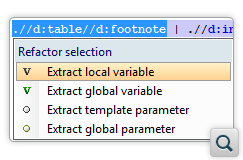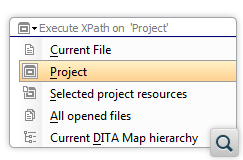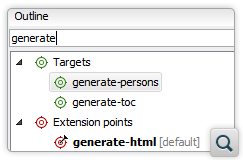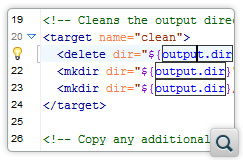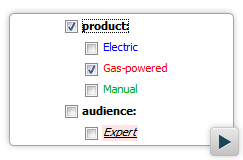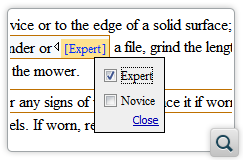Oxygen XML Editor 16.0
Oxygen XML Editor 16 increases your productivity for XSLT development with the
addition of Quick Fixes and improvements to refactoring actions. Saxon-CE specific
extensions are supported and you can apply XPath queries on multiple files.
If you use Ant to orchestrate build processes then Oxygen will support you with a
powerful Ant editor featuring validation, content completion assistance, Outline view,
syntax highlight and search, and refactoring actions.
Working with conditional content is a lot easier, since you can set different colors and
styles for each condition, or focus exclusively on a specific deliverable by hiding all
excluded content. You can modify DITA and DocBook tables easily using the table properties
action.
You can customize the style of the Oxygen WebHelp output to look exactly as you want
using the WebHelp skin builder.
As usual, this version includes many component updates and updated API
functionality.
XSLT
XSLT Quick Fixes
To improve development productivity Oxygen offers rapid fixes for common
errors that appear during XSLT development. Using the Quick Fix support you can resolve
problems such as missing templates, misspelled template names, missing function,s or
references to undeclared variables or parameters.
Improved XSLT Refactoring
XSLT refactoring support has been improved by adding additional refactoring
actions and enhancements to the existing ones. If you want to re-use an XPath expression,
you can use a refactoring action to extract that expression as a variable or parameter.
The Move to another stylesheet refactoring action allows you to move one
or more XSLT global components into a new or existing stylesheet. To make refactoring
actions more accessible the Quick Assist feature displays the refactoring actions relevant
to the current editing context.
Saxon-CE Specific XSLT Development Support
Saxon-CE (Client Edition) provides integrated XSLT 2.0 support in the web
browser. XSLT stylesheets designed to work with Saxon-CE use specific extensions to
integrate with the web browser and to react to user-generated events. Oxygen helps you
develop XSLT stylesheets for Saxon-CE with special validation, content completion
assistance, and syntax highlight support, all aware of Saxon-CE extension functions and
instructions.
XPath
XPath over Multiple Files
You can easily execute XPath expressions over multiple files. You can choose
one of the predefined scopes (Current File, Project, Selected Project Resources, All
Opened Files, Current DITA Map Hierarchy) or define your own collection of
files.
XPath File Filter
You can execute XPath expressions over all the files from the selected scope or
you can define an additional filter that will select the relevant resources from that
scope. The default filter selects all the known XML file types.
Stop XPath Execution
An XPath expression executed over multiple documents may take a long period of
time to complete. During the execution of an XPath expression, the XPath toolbar displays
a Stop button that allows you to stop the processing.
Ant Editor
Oxygen provides a full-fledged Ant build files editor that includes
features such as validation, content completion assistance, Outline view, syntax highlight
and search, and refactoring actions.
Ant Outline View
The Outline view is available for the Ant build files editor, offering you an
overview of the Ant components and the possibility to focus on a specific subset using the
filter box.
Content Completion Assistant
The Content Completion Assistant offers the list of Ant components that can be
inserted in the current context. You can use it to easily insert references to components
or to define new ones.
Searching and Refactoring Actions
You have a wide variety of actions to search and rename IDs, targets and
properties.
Master Files - Contextual Editing
Ant validation, editing (content-completion and Outline view), refactoring and
component search operations work by default in the context of the Ant Master
Files.
Resource Hierarchy / Dependencies View
The relationship between Ant resources can be visualized and understood with
the help of the Resource Hierarchy/Dependencies view.
Visual XML Editing
Profiling Colors and Styles
Profiling, also known as conditional processing, allows tagging content that
will be available only in specific deliverables. This is usually implemented using
specific attributes (also called profiling attributes such as product,
audience, etc.) and setting values to them. Oxygen helps you
quickly identify the profiled sections of a document by allowing you to define colors and
styles for each profiling attribute value and to apply them automatically to the profiled
parts of the document.
Support for Editing Table Properties (for DITA & DocBook)
Properties for cells, rows, columns or the entire table can be customized using
the contextual Table Properties action. This allows setting vertical and horizontal
alignment, column and row separators, conversions between header, body and footer row
types or configuring the table frame property.
Hide Content Excluded in a Specific Deliverable
A deliverable is defined by a Profiling Condition Set that specifies what
conditional content will be included or excluded from the document. After selecting the
current Profiling Condition Set you can choose to hide the excluded content and focus on
that deliverable without any interference with the content that is not relevant in that
context.
Customizable Profiling Attributes Rendering
The profiling attributes and their values can be made visible and editable
directly in the Author visual editing mode. The colors used to render
profiling attributes and their values are customizable, you can change the default
rendering by setting custom background, border and foreground colors. You can also hide
the name of the profiling attribute.
Render the text-decoration-style CSS 3 Property
The
text-decoration-style property as specified in the
CSS
Text Decoration Module Level 3 will be rendered by Oxygen in the visual
Author editing mode. This allows you to control the style of a text
decoration (for example, to show a wavy underline).
WebHelp Skin Builder
WebHelp Skin Builder
The WebHelp output style can be customized with a CSS that can be passed as a
parameter for the transformations from DITA and DocBook to WebHelp. Oxygen provides an
online tool that allows non-technical
users to easily create these CSS customizations in a visual interface, starting from one
of the pre-defined skin templates.
DITA Support
DITA OT 1.8.4
The DITA Open Toolkit was updated to version 1.8.4.
Support for Editing DITA Table Properties
Properties for cells, rows, columns or the entire table can be customized using
the contextual Table Properties action. This allows setting vertical and
horizontal alignment, column and row separators, conversions between header, body and
footer row types or configuring the table frame property. CALS, Simple Table and Choice
Table formats are supported.
DITAVAL Content Completion Assistant
When editing a DITAVAL file, the Content Completion Assistant displays the
profiling attribute names and possible values.
Profiling-Aware DITA Key Resolution
When you work with conditional content you can focus on a specific deliverable
by enabling a profiling condition set. Some keys may be conditionally defined and
Oxygen will take into account the profiling condition set that filters out some of the
content when gathering the key definitions.
DocBook Support
Support for Editing DocBook Table Properties
Properties for cells, rows, columns or the entire table can be customized using
the contextual Table Properties action. This allows setting vertical and
horizontal alignment, column and row separators, conversions between header, body and
footer row types or configuring the table frame property. Both CALS and HTML table models
are supported.
Component Updates
Saxon 9.5.1.5
The Saxon XSLT, XQuery and XML Schema processor from Saxonica was updated to
version 9.5.1.5.
Updated TEI Schemas and Stylesheets
The TEI schema was updated to version 2.6.0 and TEI XSL stylesheets to version
7.11.0.
ANT 1.9.3
The ANT tool was updated to version 1.9.3.
POI 3.10
The Apache POI library was updated to version 3.10.
Other
Extend Framework
You can extend a base document type configuration to add or remove
functionality. When the base is modified and evolves (from one application version to
another, for example) the extension will evolve along with it. This allows the extension
to use the new features/actions added in the base.
Eclipse Author Validation Stripe
The Eclipse Plugin was enhanced to contain a vertical validation stripe in the
Author visual editing mode showing an overview of all reported
validation errors.
Editor Variable for Evaluating XPath 3.0 Expressions
The xpath_eval(expression) editor variable allows you to
evaluate XPath 3.0 expressions either statically, in non-XML contexts, or dynamically,
relative to the current element, in XML contexts. As an example, this gives you access to
all standard XPath functions such as replace(),
substring(), or upper-case() when you compute the
output file name of a transformation.
Better Application Tooltips Styling
The user interface has been improved by using rich HTML for displaying tooltip
information. For example, in the case of a validation error the tooltip may contain a link
to an external web page.
Reference Video Files in EPUB and EPUB 3 Output
You can reference popular image or video media files to be included in EPUB and
EPUB 3
Oxygen API
A detailed list of all changes to the Java API can be found here.
Maven Repository for the Oxygen SDK
Oxygen provides API to extend its functionality and also makes available
components that can be used as part of other applications - all these form the Oxygen
SDK. Starting with version 16 the SDK is available through Maven.
Early Access to Oxygen XML Author WebApp
The Oxygen XML Author WebApp provides XML authoring and review in the
browser, running Oxygen XML Author on the server in a Java EE container and generating
HTML5+JavaScript for the client side. These technology choices make the XML authoring and
review available on any device that supports HTML5 and JavaScript, so it works also on
smart phones and tablets. The Oxygen SDK includes early access to this web/mobile
XML-editing platform.
Import Global Options from an XML Document
Access to Plugin Workspace from the Author Component
Obtain the Balanced Selection
Obtain the Element Fully Surrounded in the Selection
Get the Document Type of the Currently Open XML Editor
Set Multiple Attributes to an Element
Get the Build ID of the Current Version
Execute an Author Action at a Given Offset
Obtain All Registered Editor Listeners
Obtain All Registered Editor Change Listeners
Define Scopes for a Plugin's Library
In the plugin.xml plugin configuration file you can contribute
a referenced library to the main application class loader by setting the scope attribute
to one of the following values: global and
globalHighPriority.


